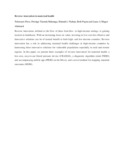Please use this identifier to cite or link to this item:
https://cris.library.msu.ac.zw//handle/11408/3793| Title: | Reverse innovation in maternal health | Authors: | Firoz, Tabassum Makanga, Prestige Tatenda Nathan, Hannah L. Payne, Beth Magee, Laura A. |
Keywords: | Geographic information systems Global health Mobile technology Reverse innovation. |
Issue Date: | 2017 | Publisher: | SAGE Publications | Series/Report no.: | Obstetric Medicine;Vol. 10; No. 3: p. 113-119 | Abstract: | Reverse innovation, defined as the flow of ideas from low- to high-income settings, is gaining traction in healthcare. With an increasing focus on value, investing in low-cost but effective and innovative solutions can be of mutual benefit to both high- and low-income countries. Reverse innovation has a role in addressing maternal health challenges in high-income countries by harnessing these innovative solutions for vulnerable populations especially in rural and remote regions. In this paper, we present three examples of 'reverse innovation' for maternal health: a low-cost, easy-to-use blood pressure device (CRADLE), a diagnostic algorithm (mini PIERS) and accompanying mobile app (PIERS on the Move), and a novel method for mapping maternal outcomes (MOM). | URI: | https://pubmed.ncbi.nlm.nih.gov/29051778/ http://hdl.handle.net/11408/3793 |
ISSN: | 1753-495X |
| Appears in Collections: | Research Papers |
Files in This Item:
| File | Description | Size | Format | |
|---|---|---|---|---|
| Reverse innovation in maternal health.pdf | Abstract | 7.41 kB | Adobe PDF |  View/Open |
Page view(s)
176
checked on Jan 20, 2026
Download(s)
54
checked on Jan 20, 2026
Google ScholarTM
Check
Items in MSUIR are protected by copyright, with all rights reserved, unless otherwise indicated.



